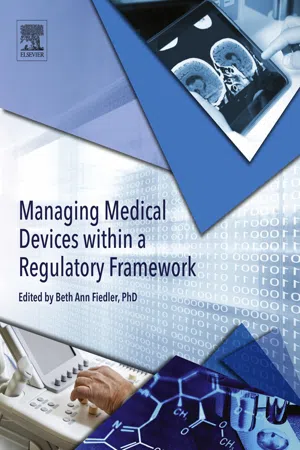
- 380 pages
- English
- ePUB (mobile friendly)
- Available on iOS & Android
Managing Medical Devices within a Regulatory Framework
About this book
Managing Medical Devices within a Regulatory Framework helps administrators, designers, manufacturers, clinical engineers, and biomedical support staff to navigate worldwide regulation, carefully consider the parameters for medical equipment patient safety, anticipate problems with equipment, and efficiently manage medical device acquisition budgets throughout the total product life cycle.This contributed book contains perspectives from industry professionals and academics providing a comprehensive look at health technology management (HTM) best practices for medical records management, interoperability between and among devices outside of healthcare, and the dynamics of implementation of new devices. Various chapters advise on how to achieve patient confidentiality compliance for medical devices and their software, discuss legal issues surrounding device use in the hospital environment of care, the impact of device failures on patient safety, methods to advance skillsets for HTM professionals, and resources to assess digital technology. The authors bring forth relevant challenges and demonstrate how management can foster increased clinical and non-clinical collaboration to enhance patient outcomes and the bottom line by translating the regulatory impact on operational requirements.- Covers compliance with FDA and CE regulations, plus EU directives for service and maintenance of medical devices- Provides operational and clinical practice recommendations in regard to regulatory changes for risk management- Discusses best practices for equipment procurement and maintenance- Provides guidance on dealing with the challenge of medical records management and compliance with patient confidentiality using information from medical devices
Frequently asked questions
- Essential is ideal for learners and professionals who enjoy exploring a wide range of subjects. Access the Essential Library with 800,000+ trusted titles and best-sellers across business, personal growth, and the humanities. Includes unlimited reading time and Standard Read Aloud voice.
- Complete: Perfect for advanced learners and researchers needing full, unrestricted access. Unlock 1.4M+ books across hundreds of subjects, including academic and specialized titles. The Complete Plan also includes advanced features like Premium Read Aloud and Research Assistant.
Please note we cannot support devices running on iOS 13 and Android 7 or earlier. Learn more about using the app.
Information
Reframing Product Life Cycle for Medical Devices
Abstract
Keywords
1.1. Introduction
1.2. FDA Total Product Life Cycle
Table of contents
- Cover image
- Title page
- Table of Contents
- Related titles
- Copyright
- Dedication
- List of Contributors
- Foreword
- Preface
- Section 1. Medical Device Development and Regulatory Overview
- Section 2. Defining and Meeting Regulatory Challenges in Clinical Engineering
- Section 3. European Markets
- Section 4. Equipment Acquisition, Integration and Maintenance
- Section 5. Data Management, Patient Safety, and Efficacy
- Section 6. Future of Healthcare
- Index